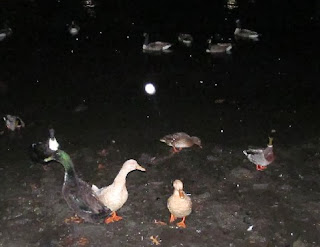Something to be thankful about! -- The Geesies are Back!
.
For the past couple of days, New York has been in a deep freeze.
.
Temperatures dipped to near record level lows and high winds caused many of the lakes and ponds in Central Park to show the first signs of freezing and ice.
.
But, the news isn't all bad.
.
Frozen lakes or ponds in places north of the city have apparently forced some local Canada geese to make their way back to Manhattan and specifically, Central Park!
.
Imagine the surprise to go to Harlem Meer the other night and discover a flock of at least 25 to 30 Canada geese resting in the middle of the water!
.
I had not seen a goose at the Meer since the death of Cago nearly two months ago. (Well, there was that flock of 5 migratory geese who landed briefly at the Meer several weeks ago, but they were promptly harassed out by Geese Police.)
.
It was thrilling to once again see geese at Harlem Meer -- especially at a time ice had formed at the east side of the lake and was also appearing around the lake's edges.
.
The more waterfowl on the water (especially heavy birds like Canada geese), the less likely the moving water is to ice over.
.
This is vital for the survival of the four domestic ducks at the Meer who are incapable of flight should the entire lake freeze over.
.
But, the question was, would the geese be allowed to stay? Or, would they immediately be harassed out by Geese Police?
.
Last night when returning to the Meer, I did not expect to still see the geese.
.
But, low and behold, they were there!
.
Obviously not elusive, purpose driven, migratory geese (who generally only rest less than a day before moving on and who almost always fly into the Jackie Onassis Reservoir) these geese were comfortable at the Meer and seemed familiar with it.
.
Some of the geese joined the mallards and domestic ducks last night in scooping up bits of cracked corn tossed on the muddy embankment, while many others were busy ducking under the water with white butts in the air, swooping up water plants or tiny insects.
.
I speculated that the fairly sizable gaggle of geese might be the same ones who, last February 9th, flew into the Meer during a bitter snow storm that likely froze up their wintering pond or lake:
.
.
At the time, the nearly 50 geese had indeed "saved the day" for the domestic ducks and small flock of mallards who were otherwise dealing with a nearly entirely iced over lake. The geese stayed for several days (until the weather warmed) and helped to maintain a large pool of open water despite the freezing temperatures and nearly a foot of snow.
.
Circumstances weren't quite so rough this time around as there was no snow and temperatures have warmed up today (though with lots of rain).
.
I am not sure if the geese will hang around a while or, if like last winter, they will return to their normal watering hole with warming temperatures.
.
Or, they could be harassed out of Harlem Meer by Geese Police which has been the story for almost the entire year so far.
.
Still, it was surprising that the geese were at the Meer (apparently unmolested) for two days in a row.
.
Did Geese Police not show up yesterday morning to harass the geese away?
.
I called my friend, Liliana (who monitors the Central Park Boat Lake and usually goes in the mornings) to ask if she had seen Geese Police over the past couple of weeks and her answer was "No," she had not seen them at all since about ten days ago.
.
Has goose harassment been suspended in Central Park for the winter?
.
From what the man from Geese Police told me, we have to surmise the answer is no.
.
But yet, it was really strange and unusual to see a large gaggle of geese at Harlem Meer for two days straight.
.
Myself, the domestic ducks and even the mallards were purely and totally delighted.
.
Our cup runneth over this Thanksgiving!
.
If Central Park has indeed suspended the dreaded Geese Police for the winter, then I and all the waterfowl of Central Park have something to be truly thankful and grateful for this Thanksgiving. -- PCA
.
**********


















